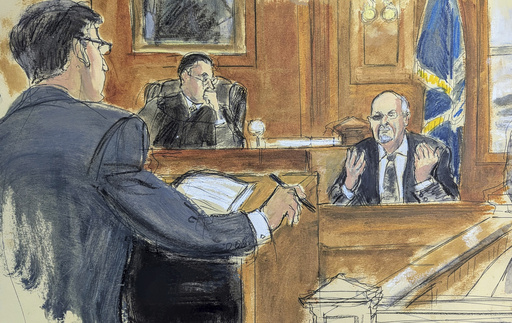MAYVILLE, N.Y. — On Tuesday, Salman Rushdie provided a vivid account of the chaotic moments during the 2022 attack when a masked individual lunged at him on stage in western New York, inflicting severe injuries with a knife. During the second day of testimonies in the trial of Hadi Matar, a 27-year-old man who has pleaded not guilty to charges of attempted murder and assault, Rushdie faced the alleged assailant for the first time since the life-threatening incident. Rushdie, now 77, conveyed how the attack left him laden with a considerable amount of blood and filled with a profound sense of pain and shock, thinking he might be close to death.
He asserted that it was the quick action of those who intervened to restrain Matar that likely saved his life. As Rushdie detailed the incident, his wife, Rachel Eliza Griffiths, was visibly emotional, crying from her spot in the courtroom. He recalled only catching a glimpse of his assailant at the last moment. “I was conscious of someone in dark clothing—a black mask concealing his face. His eyes stood out, dark and fierce,” Rushdie explained. Initially, he thought he was being struck with a fist until he saw blood spilling onto his clothing, realizing that Matar was instead attacking him with a knife.
The author described how he sustained blows to his chest and torso as he attempted to escape, ultimately succumbing to his injuries and falling to the ground. Following the stabbing, Rushdie lost sight in one eye and underwent a long recovery, spending 17 days in a hospital and numerous weeks in rehabilitation. In a memoir released since the attack, he reflected on his journey to relearn basic tasks like squeezing toothpaste. During his testimony, he noted that while he feels he has made significant strides in his recovery, he estimates he is still around 75% to 80% back to his previous self, no longer possessing the same energy or strength.
Meanwhile, Matar, located about 20 feet away in the courtroom, appeared to focus inward, often looking down during the proceedings. The public defender representing Matar, Lynn Schaffer, initiated her cross-examination by discussing Rushdie’s literary career in a tone lighter than that of the testimony. She even expressed surprise at his involvement in “Bridget Jones’s Diary,” to which Rushdie jokingly responded it was his “most significant work.”
The conversation revealed a glimpse of potential defense tactics, focusing on the possibility of memory distortion due to trauma. Rushdie did identify a particular false memory regarding his actions during the attack but was quick to clarify that the physical evidence of his injuries was undeniable, irrespective of how many strikes he received. As no one asked him to formally identify Matar in the courtroom, he left without further comments.
Heightened security measures were in place for Rushdie’s court appearance, evidenced by an increased law enforcement presence outside the courthouse. Earlier in the week, employees of the Chautauqua Institution, where the attack occurred approximately 75 miles south of Buffalo, provided testimonies related to the event. The trial is expected to span up to two weeks, during which jurors may not hear about the fatwa issued by the late Iranian leader Ayatollah Ruhollah Khomeini that called for Rushdie’s death, as the prosecution believes this context is unnecessary due to the clear nature of the attack witnessed by a live audience during Rushdie’s lecture on writer safety.
District Attorney Jason Schmidt firmly stated, “This is not a case of mistaken identity. Mr. Matar is the individual who attacked Mr. Rushdie without provocation.” Conversely, defense attorney Schaffer contended that the situation was more complex than the prosecution presented. “The elements of the crime go beyond mere negative outcomes; they are more defined. Yes, something awful occurred, but proving the crime requires much more,” she argued.
Additionally, federal authorities have indicated that Matar’s actions may have been influenced by a terrorist organization’s endorsement of the fatwa in 2006, which could lead to a separate trial on federal terrorism charges in Buffalo.




